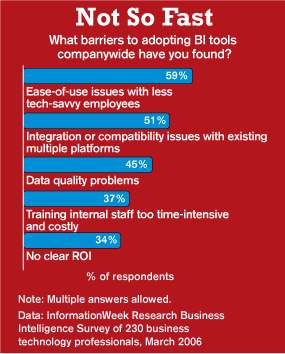The company next year will deliver a performance management application that provides business scorecarding, data analysis, and planning, budgeting, and forecasting capabilities.

How many business intelligence tools does your company use? Probably too many. That's why some companies are trying to reduce the number of BI tools they use. Microsoft wants to make sure its products are among the ones you keep.
Microsoft last week unveiled PerformancePoint Server 2007, a performance management and business scorecard application for data analysis, planning, budgeting, and forecasting. The software, which won't be available until mid-2007, will add to Microsoft's growing business intelligence line that includes reporting and analysis tools built into the SQL Server database and Office applications such as the SharePoint portal and Excel spreadsheet.

PerformancePoint, along with last week's news that Microsoft completed its acquisition of BI software vendor ProClarity, signals that Microsoft is becoming more aggressive in the BI market, which grew nearly 10% in 2005 to about $5.5 billion, according to IDC. "They've gained an increasing foothold in business intelligence over the last few years," AMR analyst John Hagerty says.
Bridges Built
In contrast to its take-no-prisoners approach in some markets, Microsoft has been subtle about its competition with vendors such as Business Objects, Cognos, and Hyperion Solutions, emphasizing the use of its database and other products as a business intelligence platform. Microsoft and Panorama Software last week unveiled plans to collaborate on building industry-specific software, while in April Microsoft and Hyperion inked a deal to link Hyperion's System 9 BI+ to Microsoft's SQL Server Reporting and Analysis services.
A Gartner survey of 1,400 CIOs earlier this year found that business intelligence was their top IT priority, surpassing even security. The average company has between six and 10 business intelligence products, leading to conflicting analytical results and higher costs, said Jeff Raikes, president of Microsoft's business division, in a teleconference announcing PerformancePoint. The trend is to cut that number down to tools from just a couple of vendors.
 Microsoft isn't alone in wanting a bigger slice of the business intelligence pie. IBM last week said it's incorporating Actuate's reporting and performance-management software into IT systems it builds for financial services companies. SAP in May made its business intelligence accelerator technology, which had been available on a limited basis, more widely available for speeding query response times for its NetWeaver Business Intelligence software. And Oracle in March debuted its Oracle Business Intelligence Suite, which integrates Oracle's BI and middleware products with the Siebel Business Analytics technology Oracle acquired. All the while, software vendors such as Business Objects and Cognos continue to expand their product offerings.
Microsoft isn't alone in wanting a bigger slice of the business intelligence pie. IBM last week said it's incorporating Actuate's reporting and performance-management software into IT systems it builds for financial services companies. SAP in May made its business intelligence accelerator technology, which had been available on a limited basis, more widely available for speeding query response times for its NetWeaver Business Intelligence software. And Oracle in March debuted its Oracle Business Intelligence Suite, which integrates Oracle's BI and middleware products with the Siebel Business Analytics technology Oracle acquired. All the while, software vendors such as Business Objects and Cognos continue to expand their product offerings.
PerformancePoint will be a focal point for Microsoft's BI technologies, tapping into SQL Server's Analysis and Reporting services and presenting the data to Excel and SharePoint Portal. Businesses will be able to program PerformancePoint with business rules and key performance indicators to match their needs. Microsoft also has plans to link PerformancePoint to its Dynamics line of financial, CRM, and supply chain management applications. The first version of PerformancePoint will emphasize financial performance management; ultimately it will be useful for monitoring and managing operational, marketing, and sales performance. While reporting generally helps information workers understand what's happened in the past, Raikes said PerformancePoint will provide insight into business processes on a real-time basis and forecasting capabilities for looking ahead.
PerformancePoint, scheduled for beta release in November, will incorporate ProClarity's analytical engine and visualization software, as well as planning software Microsoft has been developing under the code name Biz#. Business Scorecard Manager 2005, an existing product, also will be merged into PerformancePoint.
Help For Nonprogrammers
Online travel services company Expedia uses SQL Server Analysis Services, Business Scorecard Manager, SharePoint, and an early version of Office 2007 to manage data, such as Web site performance information, used by the company's customer satisfaction and Six Sigma programs. But accessing and maintaining that data is difficult for workers without programming expertise, says Laura Gibbons, customer satisfaction and Six Sigma manager. PerformancePoint will make accessing that data much easier and even let the company develop business scorecards on individual hotels. "There's a lot of potential here," she says.
Of all the workers who could be using business intelligence tools, only about 20% to 30% are doing so, Raikes said. Business analysts and technically savvy employees are the primary users of BI software, while the majority of information workers rely on desktop tools such as Excel.
That gives Microsoft a huge advantage if it can deliver business intelligence capabilities through desktop software such as Excel and SharePoint that users already are familiar with. The new release of Excel in Office 2007, for example, will provide more BI capabilities such as color-coded trend indicators and improved integration with SQL Server Analysis Services. It also will provide a way to centralize spreadsheet data using SharePoint, eliminating the common complaint of proliferating spreadsheets with conflicting data.
Microsoft is still working through plans for how the ProClarity client software might be incorporated into Office. A more detailed product road map is due later this summer. Some analysts say the ProClarity acquisition confuses Microsoft's stated plan to position Office as its front-end business intelligence software. But Dan Rosman, IT director at candy maker Jelly Belly, would like to see Microsoft offer ProClarity as a front-end tool. "Microsoft has done an excellent job on the back end. But I've always wondered why they didn't have a business intelligence client," he says. Jelly Belly's business intelligence system uses a combination of Microsoft and Panorama software.
Don't Discount Microsoft
Microsoft has a price advantage over competitors, given the low cost of its database and desktop software. Sasfin Bank in Johannesburg, South Africa, used Microsoft products such as SQL Server, SharePoint, and an early version of Office 2007 to assemble a data warehouse system to comply with that country's regulations for risk management and financial reporting. The project cost about $2.5 million in U.S. dollars using Microsoft products, compared with an estimated $8 million to $9 million using products from other vendors, CTO Peter Oeschger says.
Executives at competitors such as Cognos and Hyperion profess to be unconcerned by Microsoft's moves, noting that PerformancePoint is designed to work only with other Microsoft products--a limitation in today's heterogeneous IT environments. They also note that Microsoft's track record for delivering products when promised has been poor at best.
When Microsoft enters a market, it increases market awareness and sales tend to increase for all vendors with competing products, says Howard Dresner, Hyperion's chief strategy officer. The same could happen with performance management, Dresner says. "In some ways, Microsoft acts as a market catalyst and grows sales for everybody," he says. But he's quick to add: "We're not discounting them, by any means."
He'd better not. The IT graveyard is littered with companies that professed to be pleased when Microsoft entered and validated a market, only to see their sales decline rather than increase.
About the Author(s)
You May Also Like







